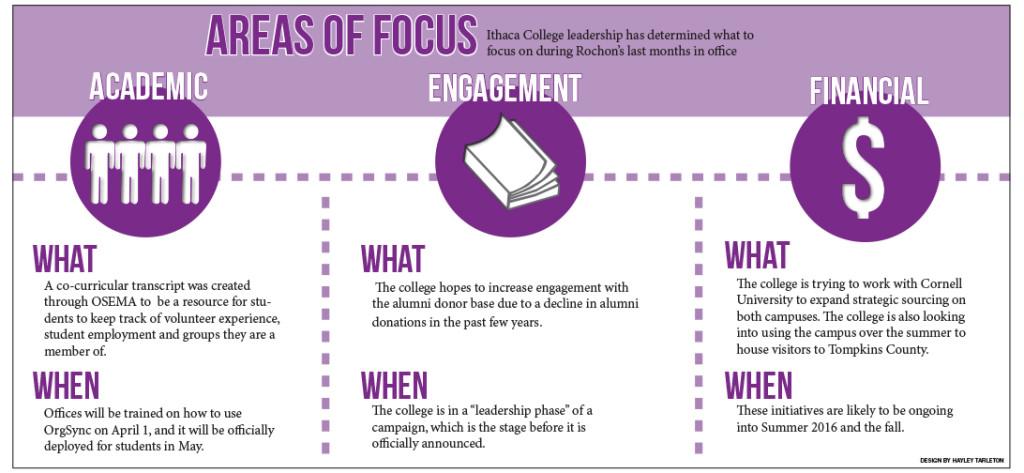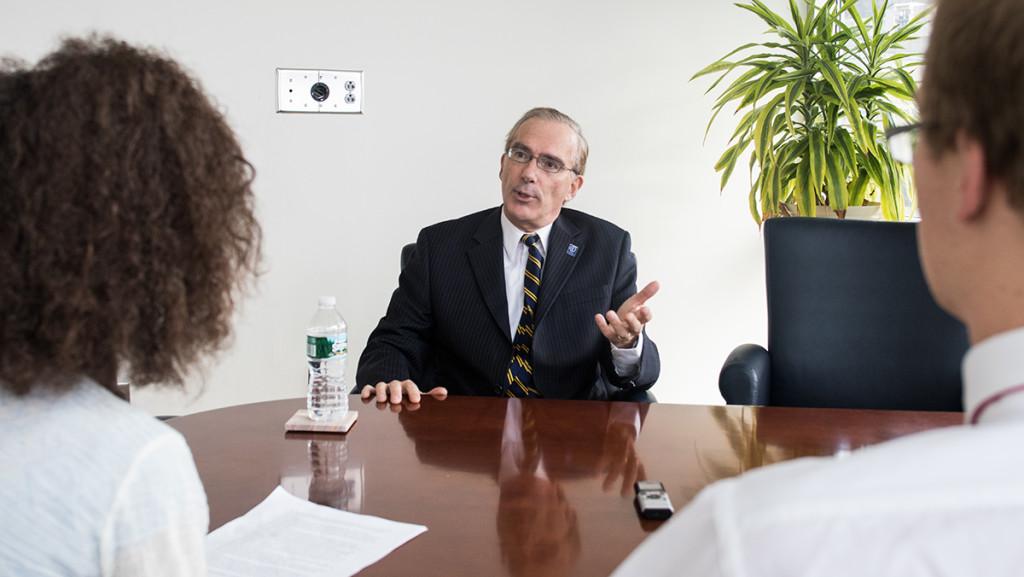Creating a 17-Month Timeline
The Ithaca College leadership has narrowed its areas of focus for the last 17 months of President Tom Rochon’s tenure. The college will focus on enhancing academics, strengthening engagement and growing the financial health of the college, while also continuing work on shared governance and diversity and inclusion.
“There are overarching goals that have been very consistent from year to year … so the discussion in a given year is really about what specific things are we going to do in those overarching, big–picture frameworks,” Rochon said.
Specific initiatives that will be worked on in those three areas include a co-curricular transcript to detail students’ involvement outside of the classroom at the college; raising the donor-base of alumni at the college; continuing with the strategic sourcing initiatives, which means finding price-efficient sources for goods and services; and developing programs that could generate sources of revenues outside of tuition.

The Process
The goals were developed through collaboration with the vice presidents, deans and the Ithaca College Board of Trustees. Each year, Rochon said, these groups meet from June to October to form a “road map for Ithaca College.” To plan for the next 17 months, the groups used the same process, but expedited it to reflect the given timeline. However, Rochon said, not all initiatives have hard deadlines yet.
Rochon said a main point of discussion was which goals should be set aside to give the new president an opportunity to re–evaluate them and maybe move forward with a fresh perspective.
The initiatives that will no longer be looked at by current leadership are the China Center and the workforce analysis program. The China Center was a proposed Ithaca College center in Shanghai, China, which Rochon said in 2013 would include classes and internships. The workforce analysis program was an initiative to cut staff positions, beginning in August 2013. Fifty-nine staff positions have been cut in 29 departments since it began. At the Jan. 21 All-College Meeting, Nancy Pringle, senior vice president and general counsel for the Division of Human and Legal Resources, announced the remaining position lines will no longer include positions that are currently filled. Pringle could not be reached for further clarification on the numbers.
Enhancing Academic Experience
To continue work on the student academic experience at the college, the Office of Student Engagement and Multicultural Affairs has been working on a co-curricular transcript, which will officially be deployed in May, Michele Lenhart, director of student leadership for OSEMA, said. She said the transcript will be a resource for students to keep track of volunteer experience, student employment and groups they are members of.
Lenhart said offices will be trained on how to use OrgSync on April 1, and beginning June 1, all co-curricular campus offices and groups can create their own portal on Orgsync.
Strengthening Engagement
Rochon said engagement in all constituencies at the college is essential in the success of the institution. He said that specifically, increasing the level of engagement in alumni, both financially and in participation with students, is important.
Similarly, Chris Biehn, vice president for Institutional Advancement and Communication, said the main area the college hopes to increase engagement in is in the alumni donor based due to a decline in alumni donations in the past few years.
Biehn was unable to disclose the plan for raising this engagement. However, he said, the college is in a “leadership phase” of a campaign — the stage before the campaign is announced.
“There is a goal that the campaign committee is working on … and that’s not a goal that has been made public yet, but there are targets along the way,” Biehn said.
Growing Financial Health
Gerald Hector, vice president for finance and administration, said he is working on a number of initiatives to help minimize the effects of the decreasing “net tuition” gain — the revenue from tuition leftover for spending. According to the 2016–17 budget, the rate of growth of the college’s expenses is outpacing tuition, the largest source of revenue.
To offset this, the college is continuing strategic sourcing by working with vendors like Staples to renegotiate contracts. Hector said the college is also in the planning stages of working with Cornell University to expand strategic sourcing to include both campuses, due to the geographic proximity.
Additionally, the college is looking into other ways to generate revenue. This includes working with the Tompkins County Visitor Bureau to see if the campus can be used over the summer to house visitors. Hector said the college is also looking into creating an urban campus, possibly situated in New York City, to see if there is enough interest to generate revenue.
SGA Reacts
At the Student Government Association’s Feb. 29 meeting, SGA President Dominick Recckio commented on the college’s announcement, released Feb. 29, referencing the goals for the next 17 months. Recckio said he was disappointed in the college’s lack of inclusion of student voices.
“That should have been a wider discussion before these things were voted on or decided on,” Recckio said. “I am consistently disappointed, and this is just another great example of centralizing the initiatives of this college.”
Recckio also expressed concern over how diversity and inclusion would be integrated into Rochon’s other goals for the college, as they were mentioned in the introduction to the announcement but were not referenced in each subsequent “area of focus.”
In Fall 2015, the college set a timeline for addressing diversity and campus climate. Roger Richardson, associate provost for diversity, inclusion and engagement and interim chief diversity officer, said it is not realistic for all deadlines to be met.
Regarding how these goals will be evaluated by the next president at the end of Rochon’s 17 months, Rochon said different priorities could be set by new leadership.
“Given that I now have a timeline of 17 months, we need to be respectful of the next president and the conversations that person will have with the board,” Rochon said. “The timing is different, but in a way, the process was the same and the big picture message.”








